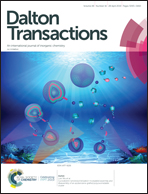Effectiveness of phase- and morphology-controlled MnO2 nanomaterials derived from flower-like δ-MnO2 as alternative cathode catalyst in microbial fuel cells†
Abstract
Crystal phase and morphology variations obtained by simple high-temperature annealing offer promising strategies for employing nanostructured manganese oxide as a cathode catalyst for microbial fuel cells (MFCs). This study examines the effectiveness of simultaneous-phase and morphology-controlled manganese dioxide nanomaterials, designed by annealing a hydrothermally synthesized flower-like δ-manganese dioxide precursor at 300–800 °C, as cathode catalysts for MFCs. MFCs with the best-performing catalyst cathode (at a reasonable mass loading) were also analyzed through cyclic voltammetry and electrochemical impedance spectroscopy. Among MFCs with non-annealed and annealed manganese dioxide cathodes (0.5 mg cm−2), those with the catalyst annealed at 500 °C (148 ± 7 mW m−2, CE = 13 ± 1%) generated the most power (5–52%). MFCs with the catalyst annealed at 500 °C at a loading of 1 mg cm−2 as the cathode delivered the highest maximum power density (213 ± 9 mW m−2, CE = 13 ± 1%), representing 44% of that obtained using Pt/C at 0.5 mg Pt per cm2 (483 ± 11 mW m−2, CE = 18 ± 2%) and a comparatively low internal resistance (164 ± 2 Ω). Both cyclic voltammetry and electrochemical impedance spectroscopy results were consistent with empirical data. Compared with previously reported cathode materials, the annealed product from the precursor flower-like δ-manganese dioxide annealed at 500 °C (particularly at a loading of 1 mg cm−2) was a more reliable, efficient, and inexpensive sustainable cathode catalyst for scaled-up MFCs.



 Please wait while we load your content...
Please wait while we load your content...